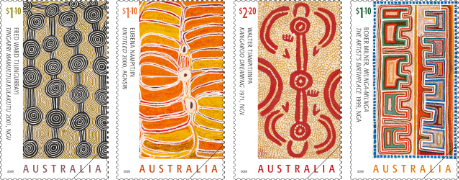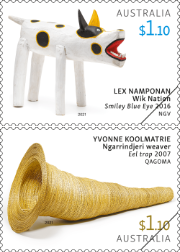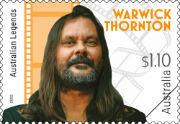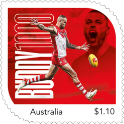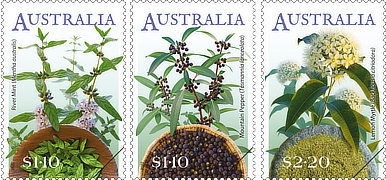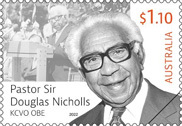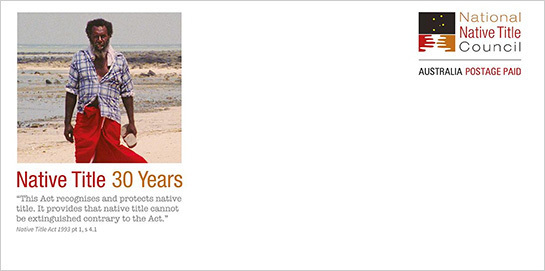Arts
Australian stamps celebrating Aboriginal culture
From the first Australian stamp showing an Aboriginal person to contemporary and beautifully designed stamps – this timeline shows them all.
Found 52 results for your search. Showing page 3 of 3.
2020
-
In its Art of the Desert issue, Australia Post features works by Aboriginal artists from the Western Desert region. Two were associated with the Warlayirti Artists in Balgo, Western Australia (Boxer Milner [Milnga-Milnga, the artist's birth place 1999] and Eubena Nampitjin [Untitled 2000]) and two with the artists’ cooperative at Papunya Tula, Northern Territory (Fred Ward Tjungurrayi [Tingarri Mamultjulkulakutu (Tingarri men travelling to Mamultjulku) 2001] and Walter Tjampitjinpa [Kangaroo Dreaming 1971]).

The artworks show paintings of the Arlayirti Artists (WA) and Papunya Tula (NT) artist cooperatives.
2021
-

Jason Gillespie is one of the 'Legends of Cricket'. The Australian Legends of Cricket stamp issue celebrates six players, among them Kamilaroi man Jason 'Dizzy' Gillespie, the first Aboriginal man to play cricket for Australia. Gillespie played all three formats of cricket – Test, One Day and Twenty20. He retired in 2008.
-

The works of Lex Namponan and Yvonne Koolmatrie show contemporary Aboriginal art. In its Australian Contemporary Sculpture issue, Australia Post shows one artwork of Lex Namponan, a Wik man from Aurukun, QLD, who is renown for his milkwood sculptures of camp dogs. The dog is a sacred totem for the clan, and his works, such as the laughing Smiley Blue Eye, combine cultural significance with popular market appeal. The other artwork is from Yvonne Koolmatrie, a Ngarrindjeri woman from South Australia. She is a master grass weaver, and her wide-ranging subjects include animals, human figures, planes and hot-air balloons, as well as traditional objects such as Eel trap, featured on the stamp.
2022
-

Warwick is one of only a handful of Australian directors to win a Caméra d'Or at the Cannes Film Festival. He earned the award for his 2009 film Samson & Delilah. Australia Post's issue of Australian Legends of Filmmaking includes one stamp featuring Kaytetye man Warwick Thornton from Alice Springs. His many films include shorts, documentaries and features and highlight First Nations topics, perspectives and experiences. Thornton is best known for feature films Samson & Delilah (2009) and Sweet Country (2017).
-

The stamp was issued as a pack of 12 in a booklet that listed Franklin's achievements. Australia Post joins the celebration of Lance Franklin's 1,000 goals with a special stamp.
-
In its Aboriginal Fibre Art issue, Australia Post features contemporary fibre art by Yolŋu women of the small inland community of Gapuwiyak (Lake Evella) in north-east Arnhem Land, Northern Territory. Made from plant fibres such as pandanus and coloured with natural bush dyes, these objects also have profound cultural, ceremonial and symbolic significance. The stamps show a coiled basket (Lucy Malirrimurruwuy Wanapuyngu, b. 1955), a twined conical container (Mary Djupuduwuy Guyula, 1945–2005) and a coiled, flat-bottomed basket (Nancy Walinyinawuy Guyula, 1940–2017).

Three stamps show woven baskets and containers, called bathi. Artists skilfully twine, coil or loop plant fibres that they coloured with natural bush dyes. -
A set of three stamps highlights First Nations peoples' Bush Seasonings. Plants made up about half of a traditional diet, and many native species also played an important roles as medicines, fibre and construction materials, and in ceremonies. The stamps feature Mountain Pepper (Tasmannia lanceolata), River Mint (Mentha australis) and Lemon Myrtle (Backhousia citriodora).

Note the different containers for the collected herbs: Wooden bowl, woven bowl and grinding stone. -

Yorta Yorta man Pastor Sir Douglas Nicholls. Australia Post honours Yorta Yorta man Pastor Sir Douglas Nicholls' 50th anniversary of becoming the first First Nations Australian to be knighted (in 1972). Doug was a footballer, pastor, Aboriginal rights campaigner, community leader and state governor. Skilled in advocacy and negotiation, Doug was committed to addressing issues of social justice for
Aboriginal people for which he received an MBE (1957) and OBE (1968). -

Rock art of the Kimberley: These pictographs were made by applying pigments to rock mixed with water, blood, plant juices or egg white. Australia Post releases two stamps featuring rock art from the north Kimberley's Wanjina Wunggurr community. One shows crocodiles, the other one Gwion Gwion figures.
2023
-
In its Sporting Treasures issue, Australia Post publishes one stamp showing the tennis racket of Evonne Goolagong Cawley, the first Aboriginal person to compete in international tennis.
-

The prepaid envelope shows Eddie Mabo, a quote from the Native Title Act 1993 and as a stamp a graphic with the Southern Cross and two hands reaching out to each other. Australia Post releases a prepaid envelope celebrating 30 years of the landmark Native Title Act 1993. It features a photograph of Eddie Koiki Mabo on Mer island.
2024
-
Australia Post releases four stamps celebrating the Kalkadoon Dreaming of the First Nations people of the Mt Isa region (QLD).
The stamps showcase the work of Kalkadoon (Kalkatungu) artist Chern’ee Sutton and represent the artist’s traditional Country. Chern’ee Sutton has been the recipient of numerous awards and honours. She has been a Queensland Day Ambassador for the Arts and a Queensland Reconciliation Awards Ambassador and her work is held in collections nationally and internationally.
